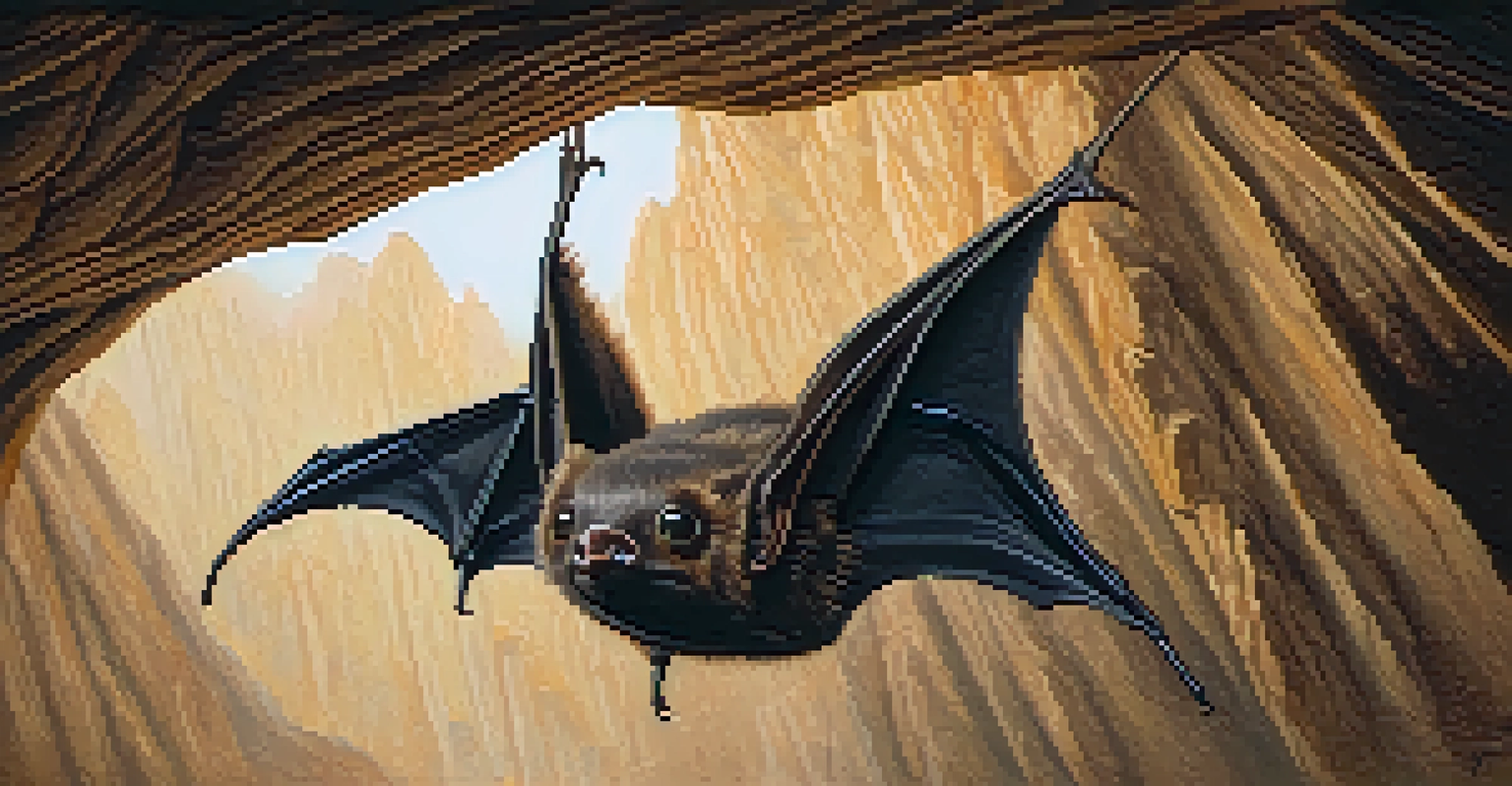Threatened Species in Tennessee: Conservation Strategies

Understanding Tennessee's Unique Biodiversity
Tennessee is home to an astounding variety of wildlife, including over 1,000 species of vertebrates and countless invertebrates. This rich biodiversity is attributed to the state's diverse habitats, from the Appalachian Mountains to the wetlands of the Mississippi River. However, this natural wealth also faces significant threats from human activities and climate change. Preserving this biodiversity is essential not only for the species themselves but for the ecosystems and communities depending on them.
The environment is where we all meet; where we all have a mutual interest; it is the one thing all of us share.
Many species native to Tennessee are classified as threatened or endangered, highlighting the urgent need for conservation. For instance, the Indiana bat and the Black-legged tick are among those at risk, facing challenges from habitat loss and disease. Understanding these species and their roles in the ecosystem is crucial for effective conservation strategies. Each species, no matter how small, contributes to the intricate web of life in Tennessee.
The state's unique biodiversity also provides a glimpse into the health of the environment. By monitoring the populations of threatened species, conservationists can gain insights into broader environmental issues. This understanding can guide efforts to mitigate impacts and promote biodiversity, ensuring that future generations can enjoy Tennessee's natural beauty.
Key Threats to Tennessee's Wildlife
Tennessee's wildlife faces a myriad of threats that jeopardize their survival. Habitat destruction due to urban development, agriculture, and logging is one of the most pressing issues. As land is transformed for human use, many species lose their homes and the resources they rely on, leading to population declines.

In addition to habitat loss, pollution plays a significant role in threatening wildlife. Contaminants from agricultural runoff can pollute waterways, affecting the animals that depend on them for survival. Furthermore, climate change is altering weather patterns and habitats, making it increasingly difficult for certain species to adapt and thrive.
Tennessee's Biodiversity at Risk
The rich biodiversity in Tennessee faces significant threats from habitat destruction, pollution, and climate change.
Lastly, invasive species pose a significant challenge to native wildlife. These non-native species can outcompete local flora and fauna for resources, disrupting the balance of ecosystems. Understanding these threats is the first step toward developing effective conservation strategies that protect Tennessee's threatened species.
The Role of Conservation Organizations
Conservation organizations play a pivotal role in protecting Tennessee's threatened species. These organizations work tirelessly to secure funding, raise awareness, and implement on-the-ground conservation projects. By collaborating with government agencies, they create comprehensive strategies that address the specific needs of endangered wildlife.
In every walk with nature, one receives far more than he seeks.
One notable organization is the Tennessee Wildlife Resources Agency (TWRA), which focuses on managing and protecting the state's wildlife resources. They conduct research, monitor populations, and implement habitat restoration projects to support at-risk species. Their efforts are crucial in maintaining healthy ecosystems and promoting biodiversity.
Community involvement is also a key aspect of conservation work. Many organizations engage local communities in their efforts, fostering a sense of stewardship and responsibility. This grassroots approach not only helps build support for conservation initiatives but also educates the public on the importance of protecting Tennessee's unique wildlife.
Habitat Restoration Efforts in Tennessee
Habitat restoration is a cornerstone of conservation strategies in Tennessee. By rehabilitating degraded habitats, conservationists aim to create the conditions necessary for threatened species to thrive. Restoration efforts can include reforestation, wetland restoration, and the removal of invasive species to allow native flora to flourish.
One successful example of habitat restoration in Tennessee is the reestablishment of native vegetation along rivers and streams. This not only benefits fish and wildlife but also improves water quality and reduces erosion. By restoring these critical habitats, conservationists help ensure that ecosystems remain healthy and resilient.
Community Engagement is Key
Involving local communities in conservation efforts fosters stewardship and enhances the protection of Tennessee's wildlife.
Furthermore, partnerships with local landowners and farmers are essential in these efforts. By promoting sustainable land-use practices, conservationists can engage communities in protecting and restoring habitats. Together, these collaborative efforts can significantly enhance the survival prospects of threatened species in Tennessee.
Community Engagement in Conservation
Community engagement is vital in the fight to protect Tennessee's threatened species. When local residents understand the value of their natural surroundings, they are more likely to participate in conservation efforts. Educational programs, workshops, and volunteer opportunities create avenues for individuals to get involved and make a difference.
For instance, citizen science initiatives allow community members to contribute to data collection on local wildlife populations. These projects not only provide valuable information for scientists but also foster a connection between people and nature. Engaging the public in this way can inspire a deeper appreciation for Tennessee's unique biodiversity.
Moreover, local events, such as clean-up days or tree planting, help raise awareness about conservation needs. By participating in these activities, community members can take tangible steps toward protecting their environment. This sense of collective responsibility is crucial in building a sustainable future for Tennessee's wildlife.
Legislation Supporting Wildlife Conservation
Legislation plays a critical role in the conservation of threatened species in Tennessee. Laws such as the Endangered Species Act provide essential protections for at-risk wildlife, helping to prevent their extinction. These legal frameworks establish guidelines for habitat conservation, species recovery plans, and funding for conservation initiatives.
In Tennessee, state laws also support wildlife conservation efforts by regulating hunting, fishing, and land use. The TWRA enforces these regulations to ensure sustainable practices that protect wildlife populations. By creating a legal foundation for conservation, lawmakers help safeguard the state's natural resources for future generations.
Legislation Supports Conservation
Legal frameworks like the Endangered Species Act are crucial for protecting threatened species and their habitats in Tennessee.
However, ongoing advocacy is necessary to strengthen and uphold these laws. Conservation organizations and concerned citizens must work together to encourage lawmakers to prioritize wildlife protection. This active engagement ensures that legislation remains effective in addressing the challenges faced by Tennessee's threatened species.
Future Directions for Conservation in Tennessee
Looking ahead, the future of conservation in Tennessee hinges on innovative strategies and collaboration. As climate change continues to pose new challenges, adaptive management practices will be essential in ensuring that conservation efforts remain effective. This approach allows for flexibility and responsiveness to changing environmental conditions.
Additionally, increased funding for conservation programs will be crucial. Securing resources for biodiversity initiatives allows for more comprehensive and long-term projects that can make a significant impact. Engaging a diverse range of stakeholders, from government agencies to local communities, will help maximize these efforts.

Ultimately, fostering a culture of conservation in Tennessee is key to protecting its threatened species. By promoting awareness and encouraging active participation, we can create a brighter future for the state's unique wildlife. Together, we can ensure that Tennessee's natural heritage is preserved for generations to come.